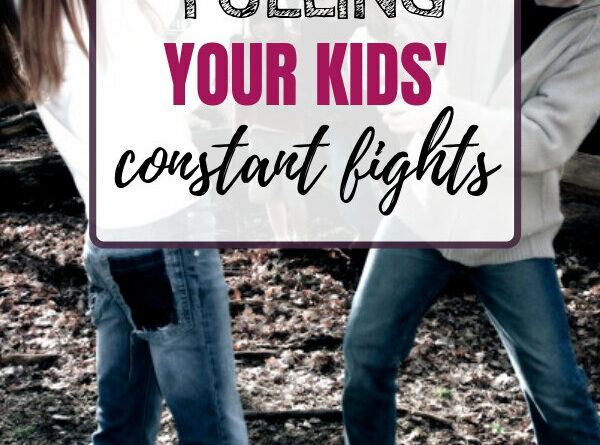9 Triggers Fueling Your Kids’ Constant Fights
You’ve about had it with those kids.
You did everything right today.
You gave them one-on-one time, you listened with empathy, you kept them entertained and fed.
And yet they’re still fighting.
They claim it’s about something important. They claim the other kid started it.
You’re starting to think it’s their favorite sport. That you should lock yourself in another room and find some other noise to drown them out.
Because seriously, what will it take for them to stop?
When the kids won’t stop fighting
Table of Contents
This is their special way of showing love
Sometimes siblings use play fighting to show affection. You shouldn’t outlaw this sort of play because these kids need it to develop and to learn self-regulation.
You’ll want to find a way to turn it into a more gentle game so no one gets hurt. Make sure everyone’s happy with the rough play and they feel cared for.
If you’re looking for tips on how to help your kids with healthy rough play, check out Lawrence J. Cohen’s book The Art of Roughhousing.
It’s their favorite sport
She’s bored, and bugging her sibling is a good way to occupy her time.
Teach your kid self-regulation skills and help her find something positive to occupy herself with. If she wants her sibling’s company, brainstorm ways that they can spend time together and both feel happy about it.
Remind her of the books she can read and games she can play with her sibling. Coach her so that next time, she’ll be able to make a better choice on her own.
Nothing, but baby gifs from your favorite show, “America’s Funniest Home Videos”.
They just discovered that life isn’t fair
Often siblings fight because they’re feeling jealous of each other. Sniping is their way of tearing their sibling down to size.
The fantastic book How to Talk so Little Kids will Listen has several tips on how to tackle jealousy between siblings.
Talk about how she’s feeling. Empathize with her.
Give her wishes in fantasy. “Do you want to be the baby? Come sit on my lap so I can give you a bottle. Da da da.”
Plan to have some one-on-one time when the sibling isn’t around. Talk about what you’ll do during that time.
Ready to help your kids stop squabbling and start getting along?
Download my Sibling Rivalry Troubleshooter free!
It’s snack time
Why can’t they just tell you they’re hungry?
Especially for young kids, communication skills seem to break down when their energy level tanks. And sometimes kids don’t even seem to realize they’re hungry. All they know is that they’re crashing and that they don’t like the feeling, at all.
When your kids are already swiping at each other, it can be hard to get them to settle down long enough to eat. I find it easiest to give them portable snacks they like to take the edge off the hunger. Once they’re feeling better it’s easier to settle them at the table for a solid meal.
Discover & share this Hungry GIF with everyone you know. GIPHY is how you search, share, discover, and create GIFs.
You’ve worked them to the bone
Tired kids have low self-control. They’re more prone to start up with each other when they’re feeling groggy.
Keep them busy and out of trouble by giving them a restful activity to do. Here are a few ideas:
Read a story together
Complete an easy puzzle (now’s not the time for challenges)
Coloring (tip: crayons are a lot neater than markers)
Listen to calm music while cuddling together
There’s too much going on
Sometimes kids feel overwhelmed by the activity around them.
If you’re with your child at a noisy party or school activity, this might just be what’s triggering your kids’ poor behavior.
It’s annoying, because these are exactly the situations where you’re desperate for your child to behave properly. Don’t get angry, though. Your child needs your help to calm down and enjoy herself.
Mary Sheedy Kurcinka’s excellent book Raising Your Spirited Child offers some excellent tips on how to calm your child when she’s feeling overwhelmed.
Think of time-out the way sports teams do. It’s not a punishment, it’s a good thing. Time-out gives your child the chance to take a break and regroup.
Help children learn to calm their bodies by providing them with calming baskets. Include books, stuffed animals, stickers, and crayons.
Teach children that they can’t leave time-out until they’ve fully relaxed. Coach them to recognize tension and calm in their own bodies.
They confused their sibling with a stress ball
Do you have a child who’s anxious and prone to meltdowns? He might just be unleashing that tense energy on the other kid.
You’ll need to coach him to find better ways to calm himself, but you’ll also need to help him make amends with his sibling. Help him ask the victim what he needs, whether it’s ice or a hug. Then help him to fix the damage.
Don’t bother with forced apologies, though. By repairing the damage, you’re teaching empathy. Forced apologies don’t teach your child anything at all.
Life’s short. Talk fast. Gilmore Girls: A Year in the Life coming soon.
It beats doing homework
Is your older child picking on your little one? They might just be avoiding something else.
If your older kid likes to procrastinate on homework on chores by starting fights, you’ll need to keep a close eye on them.
Redirect and supervise to make sure everyone’s doing what they should be. Try setting a timer and encourage them to beat it.
Discover & share this Kid GIF with everyone you know. GIPHY is how you search, share, discover, and create GIFs.
They know it’ll catch your attention
Kids need attention, and sometimes they look to get it in the craziest ways.
Sure, you’re mad at her. But you’re focusing on her and not on her sister or your email. So the plan worked, right?
Avoid these crummy attention-seeking behaviors by looking to actively “fill her cup” as well as her sibling’s. “Filling her cup” in Positive Parenting basically means making sure that she has the attention she needs to feel safe. Try spending some quality one-on-one time with each child and taking time to play with both kids together.
Conclusion
Now, don’t start thinking these tips will stop your kids’ fights. That will never happen.
But you’ll definitely be able to nip a lot of arguments in the bud. And the few that remain will be a lot easier to tolerate.
So go ahead and start studying your kids’ fight patterns. Discover what their triggers are and the signs that tip you off.
Then find another way to give them what they’re after. Because there’s always another way.




